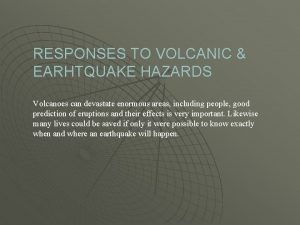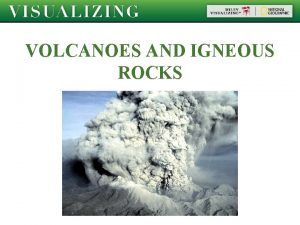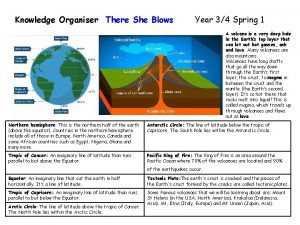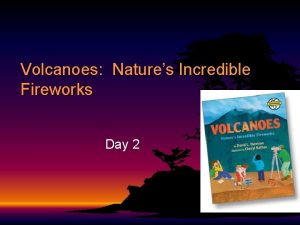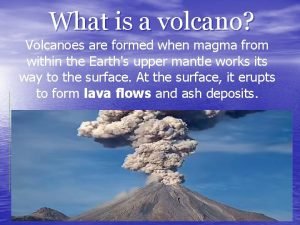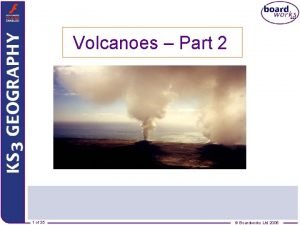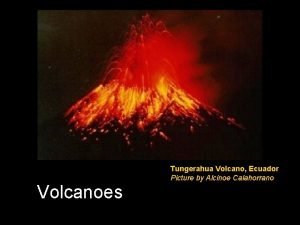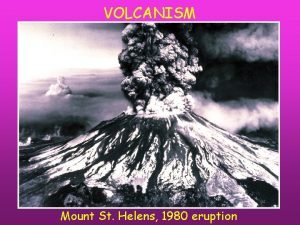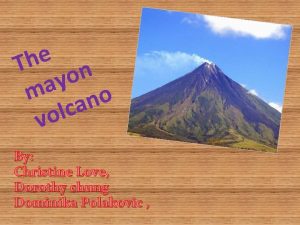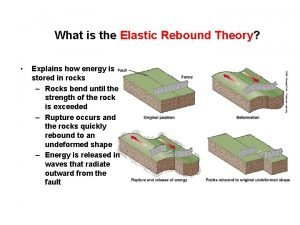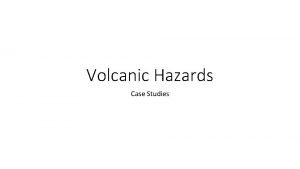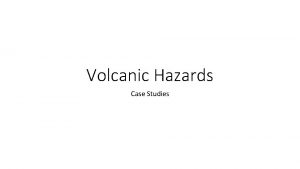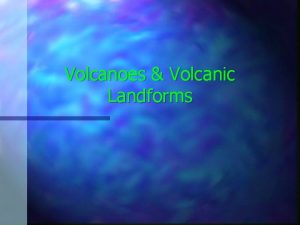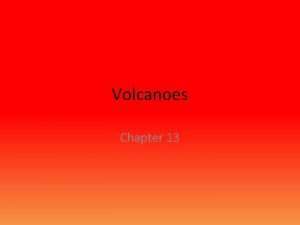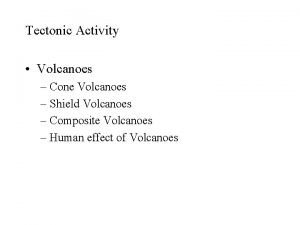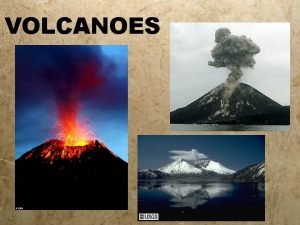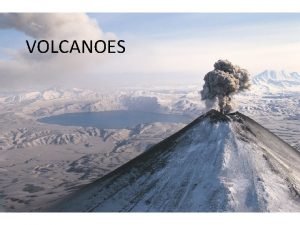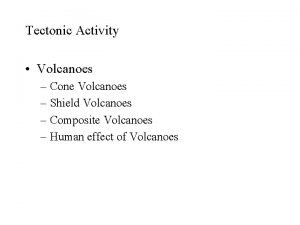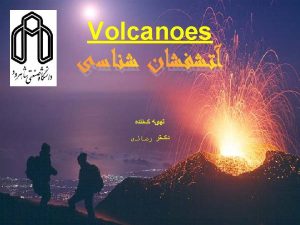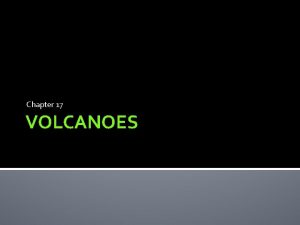RESPONSES TO VOLCANIC EARHTQUAKE HAZARDS Volcanoes can devastate













- Slides: 13

RESPONSES TO VOLCANIC & EARHTQUAKE HAZARDS Volcanoes can devastate enormous areas, including people, good prediction of eruptions and their effects is very important. Likewise many lives could be saved if only it were possible to know exactly when and where an earthquake will happen.

EARTHQUAKE PREDICTION Can seismologists predict earthquakes ? It depends on the time frame of the prediction. The distribution of seismic zones and the frequency at which earthquakes occur , we can make long term predictions (decades to centuries). Despite extensive research , seismologist cannot make accurate short term predictions (hours to weeks ). Seismologists refer to studies leading to predictions as Seismic Risk or Seismic Hazard Assessment.

LONG TERM PREDICTIONS u u When making a long term prediction of seismic risk , we use the word ‘probability’ because a prediction only gives the likelihood of an event. The basic premise of long term earthquake prediction is stated as follows: A region in which there have been many earthquakes in the past will likely experience more earthquakes in the near future. Seismologists base long term earthquake predictions first on the identification of seismic zones. Seismic zones are therefore regions of greater seismic risk. Geologists can help assess seismic risk by examining landforms for evidence of recent faulting. To identify seismic zones , seismologists produce a map showing the epicenters of earthquakes that have happened during a set period of time (say twenty years). The clusters or belts of epicenters define the seismic zone

u u u Once a seismic zone has been identified , seismologist try to determine the recurrence interval for great earthquakes in the zone. The recurrence interval can be calculated by averaging the time between several large earthquakes that happened in the past. Seismologists suspect that places called seismic gaps , where an active fault has not moved for a number of years , may be particularly dangerous. In a seismic gap , stress may be building up to be released by a major earthquake.

SHORT TERM PREDICTIONS Short term predictions, which could lead to such precautions as evacuating dangerous buildings, shutting off gas and electricity and readying emergency services, is not reliable and may never be. u Many seismologists feel that seismicity is a somewhat random process that can’t be accurately predicted. However, there are clues to imminent earthquakes and seismologists have been working hard to understand them. Some of these clues come from the detection of foreshocks. u A swam of foreshocks may indicate the cracking that preceded a major rupture along a fault zone. The surveying of the ground as before an earthquake , a region of crust may undergo distortion , either in response to build up of elastic strain in the rock or because of the development of small open cracks that cause the crust to increase in volume.

VOLCANIC PREDICTION u u Little can be done to predict an eruption at a given volcano beyond a few months or years except to define the recurrence interval (the average time between eruptions). But short term predictions of volcanoes are actually feasible. Some volcanoes send out distinct warning signals announcing that an eruption may take place very soon. Also as magma squeezes into the magma chamber it causes a number of changes the geologist can measure such as : Changes in heat flow, Changes in shape , Earthquake Activity and Increase in Gas Emission and Steam

CHANGES IN HEAT FLOW u u The presence of hot magma increase the local heat flow , the amount of heat passing through rock. When hot magma fills the magma chamber, the heat flows from the volcano to its surface. In some cases, the increase in heat flow melts snow or ice on the volcano, triggering floods and lahars before an eruption occurs.

CHANGES IN SHAPE u Tiltmeters Rising magma within a volcano often causes ground deformation. As magma fills the magma chamber inside a volcano , it pushes outward and can cause the surface of the volcano to bulge. The ground deformation is measured by tiltmeters. Tilting is for instance measured when rising magma makes a bulge. This process takes place slowly as the eruption looms. One of the most spectacular instances of bulging occurred at Mount St Helens in the 2 months before the famous 1980 eruption.

EARTHQUAKE ACTIVITY u Seismographic Monitoring or Ultra sound Rising magma causes moderate earth tremors, when the magma is approaching the surface the frequency and intensity of the tremors will increase. These shallow volcanic earthquakes are perhaps the most reliable sign a volcano is about to erupt. They can be detected by automatic telemeter recorders, relayed for immediate interpretation to an observatory. Hawaii for example has 51 such seismometers.

SEISMOGRAPH

EARTHQUAKE ACTIVITY u Surveillance by Satellite or Lasers The Global Positioning System (GPS) for example is used to monitor ground displacements, including those around volcanoes, which might pinpoint future activity.

INCREASE IN GAS EMISSION AND STEAM Chemical Sensors u u Even though magma remains below the surface, gases bubbling out of the magma or steam formed by the heating of groundwater by the volcano, percolate upward through cracks in the Earth and rise from the volcano vent. So an increase in the volume of gas emission or new hot springs, indicate the magma has entered the ground below.

THE END PREPARED BY : Ms. Fouchong
 Earhtquake
Earhtquake Devastate of the union
Devastate of the union Primary volcanic hazards
Primary volcanic hazards Volcanic hazards
Volcanic hazards Volcanoes knowledge organiser
Volcanoes knowledge organiser Volcanoes nature's incredible fireworks
Volcanoes nature's incredible fireworks How are volcanoes formed
How are volcanoes formed Magma chamber
Magma chamber Active volcanoes map
Active volcanoes map Where are volcanoes
Where are volcanoes How are volcanoes made
How are volcanoes made Interesting facts about mt mayon
Interesting facts about mt mayon What is the elastic rebound theory
What is the elastic rebound theory Types of volcanoes
Types of volcanoes
